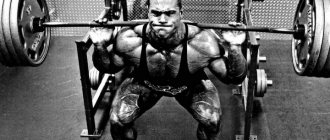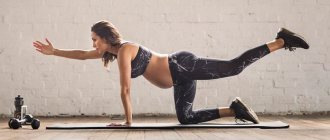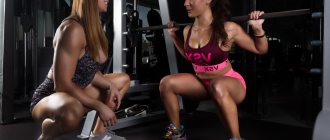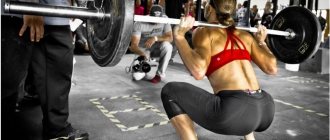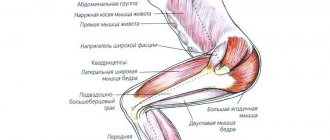Technique for performing exercises in weightlifting ( 2 votes, average: 5.00 out of 5)
Weightlifting ranks are of course important, but for beginners it will be too early to think about it. First, you need to prepare your body for the upcoming loads, hone your exercise technique, and strengthen your ligaments and muscles. You should immediately take into account that a difficult path awaits you.
Standards and tables of categories in weightlifting
Why do you need to do a barbell snatch?
The barbell snatch is one of those exercises that you can perform to evaluate your level of physical fitness. It is believed that the snatch and clean and jerk of the barbell do not directly promote muscle hypertrophy. This is not entirely true; such an opinion is a misconception. If you look at the figure of a weightlifter, we will see correct and beautiful proportions - a massive shoulder girdle, a narrow waist, muscular thighs. Every fitness enthusiast will envy these proportions. For most people, such figures look much more attractive than bodybuilders with their dysfunction or powerlifters with a lot of excess fat. Thus, if your goal is to gain muscle mass, and if you want to provide a complex load on a huge number of large muscle groups at the same time, then I recommend including the barbell snatch in your training plan.
How to do a weightlifting snatch correctly?
By following proper technique when performing the barbell snatch, you will improve your results with each workout, although the progression of loads may take quite a long time. A good stretch is required to properly perform a snatch. Therefore, before each workout in which you are going to perform this exercise, you should do a series of exercises to warm up your muscles. Focus on stretching the muscles that will be involved in the snatch. Do various variations of the splits, hanging from the bar, to stretch the spinal extensor fascia and protect yourself from unwanted injuries. A thorough warm-up of the rotator cuff is also necessary. It’s also worth stretching your hamstrings first by doing a couple of sets of Romanian deadlifts or good-morning exercises with light weights.
The entire movement is divided into several stages: tearing the bar off the floor, lifting it, squatting, getting up from the squat, fixing at the top point. Let's look at each of them:
The barbell comes off the floor
We hold the barbell as wide as possible, as long as the stretch in the pectoral and deltoid muscles is sufficient. You can use either a classic overhand grip, or take the barbell in a lock - clamping your thumb with all your fingers. We place our legs narrowly, but turn our toes slightly to the sides. The back is perfectly straight; hunching is unacceptable at any stage of the jerk. The movement should be as powerful and explosive as possible. The main thing here is speed. The bar should be kept as close to the shin as possible. When it is approximately at the level of the middle of the thigh, we move on to the next phase of the jerk - the undermining.
Detonation
The lift is needed to ensure that the bar goes through its entire amplitude as quickly as possible. This is done with a small jump or rise on the toes. Some people also advise hitting the bar against your hips to give the bar additional acceleration. This will literally make the bar fly above you. The most important thing is to accurately maintain all biomechanical angles. You cannot move the bar forward; it must rise strictly vertically. A split second after the detonation, you need to sharply go down - do a squat.
Podsed
It is important to perform the squat at the right moment. You need to have time to do this before it stops gaining speed, otherwise you will have to throw the barbell up with your hands. It is impossible to do this with a lot of weight. The drop should be quick, but in no case is it a “fall” down. To avoid injury, you need to control your body in every centimeter of the amplitude of the barbell jerk.
Squat rise
The laws of physics work in such a way that getting up from a squat is much more difficult than with regular squats. This is also why over-head squats are so hard. It is necessary to maintain balance and not let the bar tilt to one side or another. And, of course, you can’t do this without strong legs and back.
Fixation
At the top point, you need to straighten up completely and fix the barbell in straight arms. To do this, we include the triceps and deltoid muscles in the work. We wait a second until the inertia is completely extinguished and throw the barbell on the floor.
https://youtu.be/q2bcJFvW8nY
Determining the grip width (The Grip)
There is no clear formula to determine this, but there is a quick way: the athlete is fully extended, holding the bar shoulder-width apart. From this position, the athlete increases the width of his grip until the stick is in the “pocket” at the level of the hip crease. In order to check whether the PVC tube has reached the position of the pocket, you need to raise your thigh up a little: if the stick rises, then it is too low. The stick should be just above the pubic bone to avoid painful contact during lifting practice.
https://youtu.be/0_OMX2xFReQ
For people with unusually long legs and a short torso, this method is not suitable because the grip will be too wide. There is another way for them - to raise the stick to a position above the head (Overhead Position) and choose the grip width at which the stick will be at a height of 10-15 cm from the top of the head.
But also know that grip width can be changed depending on training goals and the athlete's joint mobility. For example, the wider the grip, the shorter the amplitude of movement and the higher the speed of detonation. A wide grip is suitable for people with limited mobility in the shoulder joints. And these are the advantages. Cons: The first row to the knee with a wide grip is more difficult for people with poor wrist mobility. For them, a wide grip is more painful due to the unusual angle that the hand takes while holding the bar (stick) and because of this, it will be difficult to achieve a lockout in the elbows in an overhead position. Holding the lock becomes problematic, resulting in stiff elbows and making it difficult to transition the bar to an overhead position.
A narrow snatch grip will create a stronger and more comfortable first row to the knee, a lock grip will be stronger and will reduce discomfort in the hands, it will be easier to achieve lockout in the elbows in the overhead position, but will increase the range of motion and execution time, worsen the overhead position in people with poor mobility in the shoulder joints. It will make it more difficult for your elbows to move sideways and up while pulling. Therefore, during the practice of technical exercises, the athlete will have to finally determine his comfortable grip in order to further study the snatch with the bar.
Current standards for weightlifting
In 2020, at all Russian competitions, any athlete can receive a rank by fulfilling the following standard. The standard is assigned based on the sum of two movements: the snatch and the clean and jerk.
Table of rank standards for men
| Weight category (kilogram) | MSMK | MS | KMS | I | II | III | I(yu) | II(yu) | III(ju) |
| 34 | 75 | 70 | 55 | ||||||
| 38 | 80 | 75 | 60 | ||||||
| 42 | 105 | 95 | 90 | 85 | 80 | 65 | |||
| 46 | 135 | 120 | 105 | 95 | 90 | 85 | 70 | ||
| 50 | 180 | 155 | 135 | 120 | 105 | 95 | 90 | 75 | |
| 56 | 255 | 205 | 175 | 155 | 135 | 120 | 100 | 95 | 80 |
| 62 | 285 | 230 | 195 | 175 | 155 | 130 | 110 | 100 | 85 |
| 69 | 315 | 255 | 210 | 185 | 165 | 140 | 125 | 110 | 95 |
| 69+ | 195 | 175 | 150 | 135 | 115 | 105 | |||
| 77 | 350 | 280 | 240 | 210 | 185 | 160 | 140 | 125 | 110 |
| 85 | 365 | 295 | 255 | 225 | 195 | 170 | 145 | 130 | 115 |
| 94 | 385 | 310 | 265 | 230 | 200 | 175 | 155 | 135 | 120 |
| 94+ | 315 | 270 | 235 | 210 | 180 | 160 | 140 | 125 | |
| 105 | 400 | 320 | 275 | 240 | 215 | 185 | |||
| 105+ | 415 | 325 | 280 | 245 | 220 | 190 |
Table of rank standards for women
| Weight category (kilogram) | MSMK | MS | KMS | I | II | III | I(yu) | II(yu) | III(ju) |
| 34 | 65 | 55 | 45 | ||||||
| 36 | 70 | 60 | 50 | ||||||
| 40 | 95 | 90 | 85 | 80 | 75 | 65 | 55 | ||
| 44 | 120 | 105 | 95 | 90 | 85 | 80 | 70 | 60 | |
| 48 | 165 | 130 | 110 | 100 | 95 | 90 | 85 | 75 | 65 |
| 53 | 180 | 140 | 120 | 110 | 105 | 95 | 90 | 80 | 70 |
| 58 | 190 | 150 | 130 | 115 | 110 | 100 | 95 | 85 | 75 |
| 63 | 205 | 160 | 140 | 125 | 115 | 105 | 100 | 90 | 80 |
| 69 | 215 | 170 | 150 | 130 | 120 | 110 | 105 | 95 | 85 |
| 69+ | 175 | 155 | 135 | 125 | 115 | 110 | 100 | 90 | |
| 75 | 225 | 180 | 160 | 140 | 130 | 120 | |||
| 75+ | 235 | 190 | 165 | 145 | 135 | 125 |
How to increase strength in the snatch?
More than half of success in the snatch depends on progress in the accessory exercises. The assistance prepares the muscles for the hard work of the basic exercises. Classic deadlifts, snatch grip rows, over-head squats, and various pull-ups should become an integral part of the training process if an athlete seriously wants to succeed in weightlifting. Training with reduced and increased amplitude also works well. For example, a snatch from the boards will help you better work on your tuck and squat, and a deadlift from the pit will improve your stall speed.
The principle of periodization of loads is also important. CrossFit and weightlifting are not sports where you can progress day by day. Sooner or later this will result in stagnation, and in the worst case, serious injury. Alternating the load will prevent you from overtraining your muscles and joint-ligamentous apparatus, and will also help you mentally move away a little from heavy weights and exhaustive work.
Muscles involved in the exercise
This exercise is difficult to perform technique because it is compound. It consists of a two-handed kettlebell push and a lunge. Let's look at the muscles involved in the kettlebell lunge push.
The main muscles are the legs, deltoids and trapezius muscles. The work also includes auxiliary muscles: pectoralis major, triceps, forearm, calf muscles.
When performing a kettlebell push with a lunge, the stabilizer muscles are the back muscles. If you have weak long back muscles, you may want to strengthen them by doing deadlifts or hyperextensions.
Crossfit complexes with barbell snatch
Weightlifting exercises formed the basis of more than a dozen functional complexes. We will look at the most interesting of them in the table below.
| Dinner of a mammoth | Perform 15 barbell push-ups, 30 double jump ropes, 15 barbell push-ups, 20 burpees, 20 front squats, 30 double jump ropes, and 25 barbell snatches. The goal is to complete everything in the minimum amount of time. |
| The Big Dirty | Complete a 400-meter sprint, followed by 40 each of back squats, front squats, and overhead squats. Then again a 400-meter race and 40 bench presses and jerks. Then a 400-meter race, 40 power cleans and snatches. At the end there is another 400 meter race. |
| Crossfit Games Open 15.1 | Perform 15 calf raises, 10 deadlifts, and 5 barbell snatches. The goal is to complete the maximum number of rounds in 9 minutes. |
Push
This exercise is performed second in a weightlifting competition. To perform a push, the athlete rises after squatting and fixes the position. In this case, the body should be strictly vertical, maintaining a deflection in the lower back, the feet should be spaced wider than the shoulders, the position should be as stable as possible. The elbows are brought forward, and the pelvis is moved back slightly. The bar of the bar lies on the chest, the head is slightly abducted, the gaze is directed slightly above the horizontal.
Push exercise.
Half-squat
The athlete squats shallowly, moving the pelvis back, but maintaining a vertical body position. The movement should not be performed too quickly, as in this case the bar will come off the chest and a powerful push will not work. It is necessary to use the elastic properties of the projectile. A deep squat in this phase of the exercise will also significantly complicate the subsequent push-out, so there is no need to bend your knees too much.
Pushing
Immediately from a half-squat position, the athlete, with a sharp and powerful movement, pushes the projectile vertically upward. The phase ends with almost full extension of the legs, stepping onto the toes and raising the shoulders. The bar is given a sharp acceleration, as in the case of the “undermining” discussed earlier.
Podsed
As the bar moves upward, the athlete quickly moves underneath it, extending his arms and accepting the barbell to complete the movement. Just as in the case of the snatch, the position of the legs in the squat can be either “spread” or “scissors”.
Squat rise
Exit to vertical position. The barbell is held behind the head with outstretched arms, the body is straight, there is a deflection in the lower back, the pelvis is slightly laid back. The gaze is directed horizontally.
